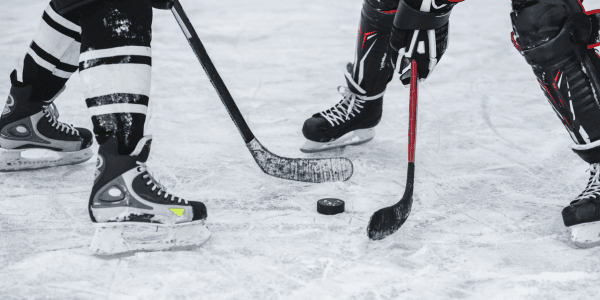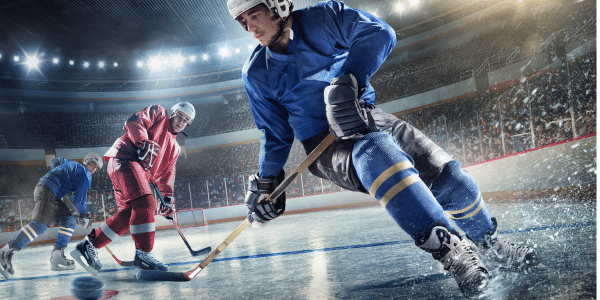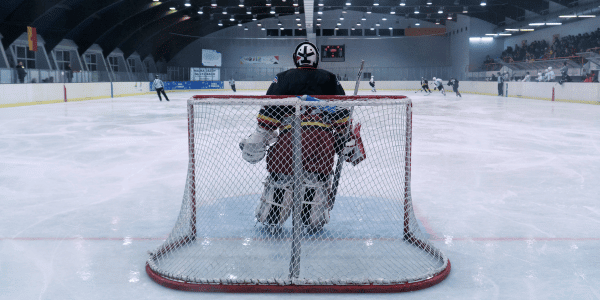Ice Breaker: How to Play Hockey For Beginners

A blend of speed, skill, and strategy, ice hockey is an exciting experience for hockey players and fans alike. The perfect sport for when temperatures cool, the game’s popularity is heating up, and if you’re new to hockey, you don’t want your knowledge to be on thin ice. Instead, follow this article about how to play ice hockey. After reading our beginner's guide to hockey, you'll skate through the season with knowledge of everything that makes up a hockey match!
Ice Hockey Basics for Beginners
Hockey Rink
The first recorded indoor ice hockey game took place in 1875. Today, ice hockey matches are played on a rectangular 200-foot-by-85-foot ice hockey rink enclosed by boards and Plexiglass.
Hockey rinks have a goal at each end and are divided into three zones. A red line with a faceoff circle at the center ice divides the ice in half, and the two blue lines at an equal distance on either side mark neutral, offensive, and defensive zones. You’ll also find various lines, dots, and circles that distinguish locations for penalties, restarts, referees, and more.
Hockey Objective
During an ice hockey game, teams decked out in protective gear glide and collide as they try to score goals by shooting a rubber disc, or “puck,” into the opposing team’s net. At the professional and college levels, ice hockey games are split into three 20-minute periods, with 15-minute intermissions between them.
If the ice isn’t your thing, football may be the right fit. Read our football guide to tackle any questions about how to play and its rules.
How to Play Ice Hockey
In a standard hockey match, both ice hockey teams place six players on the ice, including goalies. The game begins with a faceoff in the rink’s center circle, where a referee drops the puck between two ice hockey players trying to gain possession.
On offense, ice hockey players try to move toward the other team’s net to score, either by passing the puck to teammates or skating down the ice themselves. On defense, players attempt to stop the puck-carrying player’s progress with their bodies or sticks to earn offensive possession.
Whichever team has the most goals at the end is the winner. If both teams have the same number of goals after regulation time, the hockey match goes into overtime. If the score is still tied after that, a shootout may determine the winner, with one player from each team attempting to score on the opposing goalie.
Ice Hockey Rules and Regulations
Ice hockey has a very physical style of play. Ice hockey rules and regulations permit body checking, which allows hockey players to use their bodies to stop the puck carrier. Not all contact is tolerated, though. Penalties are assessed for excessive roughness and rule violations, like tripping, holding, and other unregulated contact with players and hockey sticks.
Why Is Fighting Allowed in Hockey?
With players going full force, don’t be surprised if you see a fight or two break out. Why is fighting allowed in hockey? Well, it’s all a part of the culture that makes hockey unique, strengthening bonds between teammates and increasing game-day intensity.
While fights typically play out, involved players may receive penalties for roughing. Penalties force the offending player to sit outside the ice rink in a penalty box, leaving their team short-handed for a period of time.
Hockey is the perfect winter activity, but it isn’t the only option. Check out our list of our favorite skiing spots today!
Hockey Positions Explained
Ice hockey players hit the ice in one of six positions: three forwards (a center and two wingers), two defensemen, and one goalie, each with a distinct role:
- Hockey Center: As its name suggests, this position occupies the central part of the ice. These players act as the playmakers and scorers on offense and disruptors on defense. They are also usually responsible for their team’s faceoffs.
- Hockey Wingers (left wing and right wing): These two primarily focus on offense, working with the center to create scoring opportunities and pressuring the other team’s defenders.
- Hockey Defensemen (left and right): They assist their goalie by aggressively disrupting the offensive players with their bodies and hockey sticks. After successfully stealing the puck, they turn into initiators on offense, passing the puck down-ice to their center and wingers.
- Hockey Goalie: Also known as a goaltender, a goalie is the last line of defense. They stand directly before their team’s goal line to block opposing shots.
Ice Hockey Terms
To truly appreciate hockey and get the gist of ice hockey basics for beginners, you need to understand ice hockey terminology:
- Power play: When one ice hockey team has more players on the ice than the other, often because an opposing player is serving a penalty.
- Penalty kill: The act of defending against a power play.
- Offside: A violation that occurs if an attacking ice hockey player enters the offensive zone before the puck, resulting in a stoppage of play and a faceoff outside the offensive zone.
- Icing: A violation for a player that shoots the puck across the ice rink’s center and the opposing team’s goal line without another player touching the puck. Play is stopped, and a faceoff occurs in the offensive team’s defensive zone.
- Hat trick: When an ice hockey player scores three goals in one game. Traditionally, fans throw hats onto the ice to celebrate.
- Breakaway: When an offensive player possesses the ice hockey puck with only the goalie between them and the goal.
- Deke: Shifts of the body and feet by offensive hockey players used to get defenders out of position.
Beyond How to Play Ice Hockey: More Sports Studying
Now that you know how to play hockey thanks to our ice hockey basics for beginners guide, continue your education in athletics with our basketball guide, “Nothing but Net.” In it, you’ll find out how to play basketball, where the game was invented, how its format varies by league, the players’ positions, and so much more. Take a shot at learning the game today!
Ice Hockey FAQs
Who invented ice hockey?
Indoor ice hockey, an evolution of stick-and-ball games played thousands of years ago, originated in Canada in 1875.
How many periods in hockey?
A standard hockey game is played in three 20-minute periods, with two intermissions of about 15 minutes between them.
How thick is hockey ice?
Most hockey rinks have ice that is about .75 to 1.5 inches thick.
How long is a hockey game?
Hockey games take place over three 20-minute periods without overtime, totaling 60 minutes. With intermission, commercials, and potential overtime/shootouts, National Hockey League (NHL) games can take 2 ½ - 3 hours to complete.
When does hockey season start?
In America, hockey season usually starts in the early fall and continues through the winter or spring, depending on the league and level of play.

